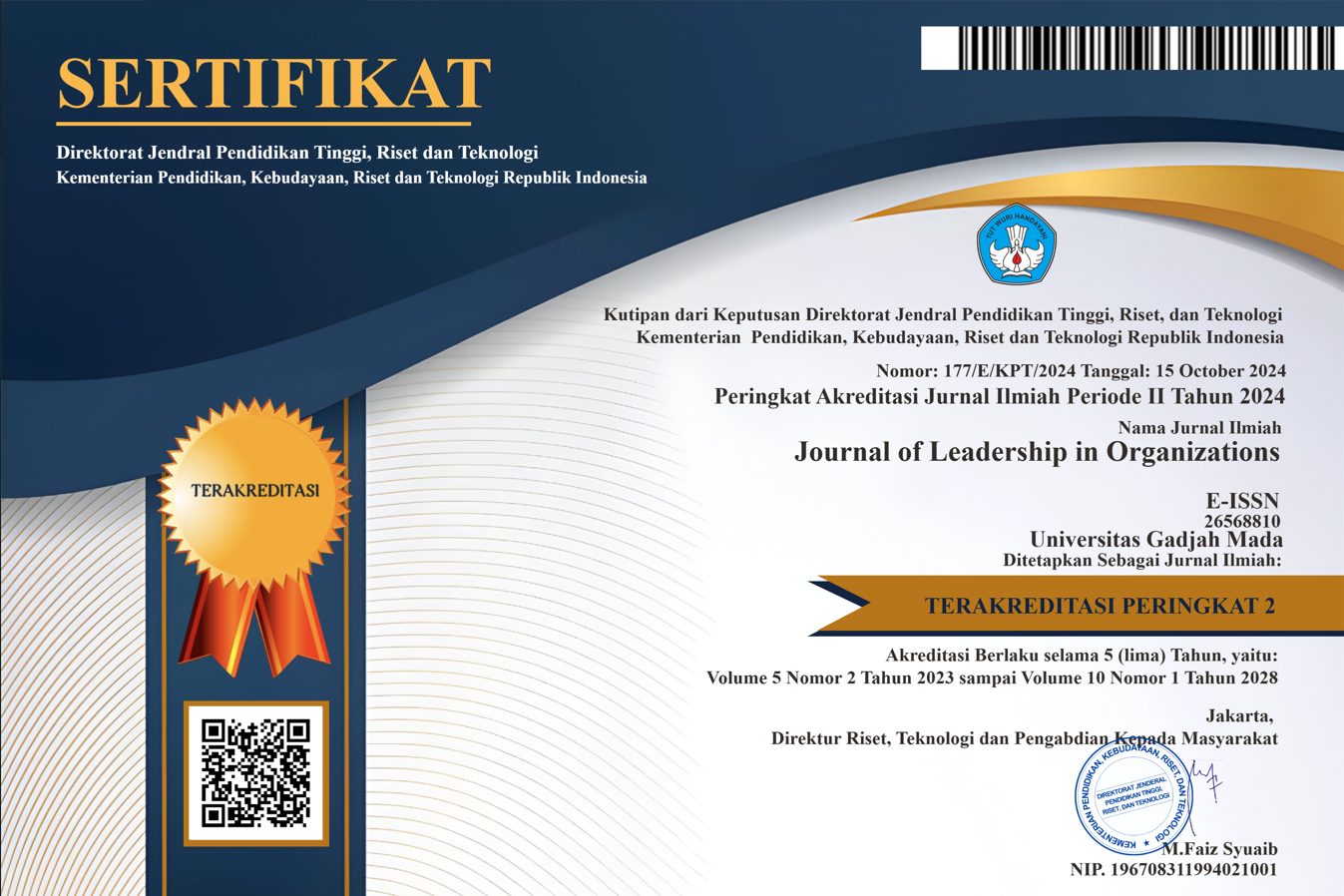ANALYSIS OF LEADERSHIP STYLE BY USING THE MODEL OF HERSEY AND BLANCHARD
Adi Lukman Hakim(1*), Erna Nur Faizah(2), Ninik Mas'adah(3)
(1) Universitas Muhammadiyah Lamongan
(2) Universitas Muhammadiyah Lamongan
(3) Universitas Muhammadiyah Lamongan
(*) Corresponding Author
Abstract
Introduction/Main Objectives: This research raises human resources management within the crediting bank, where employees require reliable and competent leadership. Leadership is categorized as the concept of empowering when the leader shares direction, a support system, friendly, synergizing, and providing exemplary examples to his subordinates.
Background Problems: Through scientific ways, this study attempted to respond to the research questions, which are: 1) how is the maturity of employees in the Anugerah rural bank located in Purwosari, 2) what are the applications of leadership styles, duty behavior, and relationship behaviors at there, and 3) in which quadrant of leadership styles of the chief of operational, general, administrations, and marketing department?
Novelty: The current study engaged four situational leadership in a model.
Research Methods: The survey design administered the questionnaire, interviews, and observation to the target samples. The data, then analyzed using descriptive analysis and the range scale.
Finding/Results: The operational and general divisions reflect their leadership styles in quadrant II representing a consultation or low task and relationship behavior. Besides, quadrant III, which implies a participating leadership style with high task and relationship behavior, has been practiced by the marketing department. The administrative division tends to use the leadership style from quadrant IV or delegating with high task behavior relationship.
Conclusion: Leaders can select any leadership style, but they must remain aware of task and relationship behavior. This recent study has many limitations; hence, the future researcher can apply other leadership styles under different conditions.
Keywords
Full Text:
PDFReferences
Anthony, Felix. & Remiasa, M. (2019). Analisis Gaya Kepemimpinan Situasional PT Futurefood Wahana Indust. Agora, 7(1).
Arifin, Z. (2014). Penelitian Pendidikan: Metode dan Paradigm Baru. Bandung: PT. Remaja Rosdakarya.
Dermawan, P., Susilo, H., & Aini, E. K. (2018). Pengaruh Gaya Kepemimpinan Situasional terhadap Kinerja Karyawan dengan Motivasi Kerja sebagai Variabel Intervening. Jurnal Administrasi Bisnis (JAB), 60(2), 95–104.
Faizal, T. D. (2018). Analisis Gaya Kepemimpinan di PDAM Kota Probolinggo (Model Hersey dan Blanchard). Jurnal Manajemen Bisnis, 8(2), 125–133.
Ferdinand, A. (2014). Metode Penelitian Manajemen. Semarang: BP. UNDIP.
Flippo, B. E. (2013). Personel Management (Manajemen Personalia) (Edisi 7). Jakarta: Erlangga.
Ghozali, I. (2016). Aplikasi Analisis Multivariete Dengan Program IBM SPSS 23 (Edisi 8). Semarang: Universitas Diponegoro.
Hadi, R.P. & Prasetya, A. (2018). Pengaruh Gaya Kepemimpinan Situasional dan Lingkungan Kerja terhadap Kinerja Karyawan Melalui Motivasi Kerja pada Karyawan PG. Watoetoelis Sidoarjo. Jurnal Administrasi Bisnis (JAB), 60(3), 87–95.
Harbani, P. (2013). Kepemimpinan Birokrasi. Bandung: Alfabeta.
Hasibuan, M. S. P. (2017). Manajemen Sumber Daya Manusia. Jakarta: PT Bumi Aksara.
Henkel, T. G., & Bourdeau, D. T. (2018). A Field Study: An Examination of Managers’ Situational Leadership Styles. Journal of Diversity Management, 13(2), 7–14. https://doi.org/10.19030/jdm.v13i2.10218
Kadarusman, D. (2012). Natural Intelligence Leadership : Cara Pandang Baru terhadap Kecerdesan dan Karakter Kepemimpinan. Jakarta: Raih Asa Sukses.
Lagantondo, H. (2018). Gaya Kepemimpinan Camat dalam Upaya Mencapai Tujuan Organisasi Kantor Kecamatan Lore Barat Kabupaten Poso. Jurnal Ilmiah Administratie, 11(1), 11–20.
Rahayu, I.D., Musadieq, M. AI., & Prasetya, A. (2017). Pengaruh Gaya Kepemimpinan dan Program Keselamatan dan Kesehatan Kerja Terhadap Motivasi Kerja (Studi pada Karyawan Tetap Maintenance Department PT Badak LNG Bontang). Urnal Administrasi Bisnis (JAB), 43(1), 1–9.
Raza, S.A. & Sikandar, A. (2018). Impact of Leadership Styl of Teacher on the Performance of Students: An Application of Hersey and Blanchard Situational Model. Bulletin of Education and Research, 40(3), 73–94.
Rivai, V. (2013). Manajemen Pemimpin dan Kepemimpinan dalam Organisasi. Jakarta: Rajawali Pers.
Rivai, V. (2015). Manajemen Sumber Daya Manusia untuk Perusahaan. Jakarta: Rajawali Pers.
Robbins, S. & Judge, T. . (2017). Organizational Behavior (Edisi 13,). Jakarta: Salemba Empat.
Robbins, S.P & Coulter, M. (2016). Manajaemen (Jilid 1. E). Jakarta: Erlangga.
Robbins, S. (2015). Perilaku Organisasi. Jakarta: Salemba Empat.
Sedarmayanti. (2017). Manajemen Sumber Daya Manusia : Reformasi Birokrasi dan Manajemen Pegawai Negeri SIpil. Bandung: PT. Refika Aditama.
Setiawan, A. (2017). Pengaruh Gaya Kepemimpinan Partisipatif terhadap Kinerja Karyawan Melalui Motivasi Kerja dan Kepuasan Kerja. Agora, 5(3).
Sugiyono. (2016). Metode Penelitian Kuantitatif, Kualitatif, dan R&D. Bandung: Alfabeta.
Thoha, M. (2015). Kepemimpinan dalam Manajemen (Edisi 18). Yogyakarta: PT. Raja Grafindo Persada.
Thoha, M. (2016). Perilaku Organisasi, Prinsip Dasar dan Aplikasinya. Yogyakarta: PT. Raja Grafindo Persada.
Thoha, M. (2017). Kepemimpinan dalam Manajemen. Jakarta: PT. Raja Grafindo Persada.
Thompson, G. & Glaso, L. (2018). Situational leadership theory: a test from a leader-follower congruence approach. Leadership & Organization Development Journal, 39(5), 574–591. https://doi.org/10.1108/LODJ-01-2018-0050
Umar, H. (2013). Metode Penelitian untuk Skripsi dan Tesis Bisnis. (Edisi 1.). Jakarta: PT. Gramedia.
Vandayani, P., Kartini, D., Hilmiana., & Aziz, Y. (2015). The Impact of National Culture on Effectiveness of Situational Leadership Hersey-Blanchard. International Journal of Scientific & Technology Research, 4(7), 78–82.
Yukl, G. (2015a). Kepemimpinan dalam Organisasi (Edisi 7). Jakarta: Indeks.
Yukl, G. (2015b). Leadership in Organizations (Edition Se). Jakarta: PT. Indeks.
Zigarmi, D. & Roberts, T. P. (2017). A Test of Three Basic Assumptions of Situational Leadership II Model and Their Implications for HRD Practitioners. European Journal of Training and Development, 41(3), 241–260. https://doi.org/10.1108/EJTD-05-2016-0035
Article Metrics
Refbacks
- There are currently no refbacks.
Copyright (c) 2021 Journal of Leadership in Organizations

This work is licensed under a Creative Commons Attribution-ShareAlike 4.0 International License.
| Journal of Leadership in Organizations |
| Journal of Leadership in Organizations (JLO), with registered number ISSN 2656-8829 (Print) and ISSN 2656-8810 (Online), is published by the Center for Leadership Studies, Department of Management, Faculty of Economics and Business, Universitas Gadjah Mada. The content of this website is licensed under a Creative Commons Attribution-ShareAlike 4.0 International License |
| © 2019 Journal of Leadership in Organizations | |





_logo2.png)


.png)




